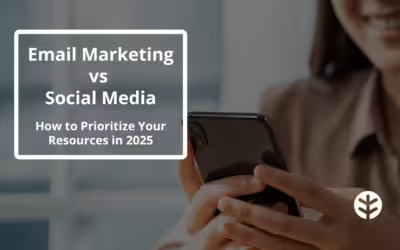You’ve developed your practice and business. But how about brand development? Whether you’re just starting, in the middle of your journey, or well-established in your wellness practice, a strong brand—and the strategic brand development that leads to it—can mean the difference between just surviving and fully thriving.
Your brand is the outward expression of your business, the impression you’ve made in your current and future customers’ hearts, minds, and lives. Like a seed, your brand probably sat quietly buried in your mind before you started your wellness business journey and has since sprouted into words, colors, values, feelings, messages, images, experiences, and more that are uniquely your own.
Brand development takes all these elements and intentionally shapes them into a powerful force that resonates with your target audience, communicates your unique value, and sets you apart from your competitors.
Brand development can be overwhelming at first, but remember, every worthwhile journey starts like that. In this comprehensive guide, we’ll walk you through the essential components of brand development and provide a step-by-step approach to creating a powerful brand development strategy.
Table of Contents:
What Is Brand Development?
Simply put, brand development is the process of establishing your brand and taking steps to increase its impact on your target audience. More specifically, it’s the strategic process of creating, nurturing, and managing your business’s unique identity and perception.
Brand development is crucial for wellness business owners. Strategic brand development goes further than simply establishing your business (which is a terrific accomplishment)—it establishes your business’s unique personality and identity, helping you stand out in a competitive market, build trust with your clients, and establish a loyal following.
Brand development goes beyond a name, look, and feel. It gets to your business’s core values, personality, and promise. From this deeper level, you can then consistently communicate, connect, and convert more effectively through strategic touchpoints like your website, social media, direct client interactions, and environmental touches in a physical space.
By taking the time and putting in the effort to apply a strategic approach to developing your brand, you are more easily able to:
- Differentiate yourself and your offerings from competitors
- Highlight your unique value proposition
- Create an authentic emotional connection with your target clients
- Establish credibility and trust to foster long-term relationships
- Carve out your niche and connect your business to your community
Brand Development vs Branding
You may be thinking at this point, “Wait. Why are we talking about brand development? Isn’t this just branding?” Well, yes and no. While often used interchangeably, brand development and branding are two different concepts:
- Brand development, what we’re focused on here, is the strategic process of creating and managing your brand identity
- Branding is the tactical execution of that strategy through various visual and communicative elements, such as your logo, color scheme, tone of voice, and messaging
In essence, branding flows out from brand development.
Common Mistakes to Avoid
Brand development can be an awful lot of fun. It’s creative, reflective, strategic, and analytical. While your brand development journey will be uniquely your own, it’s important to be wary of some pitfalls common to the process. These pitfalls are present no matter what industry you’re working in.
Many businesses make the mistake of focusing on developing a beautiful logo or coming up with an alluring, inspiring name. These are essential to your brand, but it’s important to create these at the right point in the process (and it’s necessary to make this your only brand development work). The more brand development work you do before you create these elements, the more informed, aligned, and powerful they’ll ultimately be.
Another misstep is turning down the volume of your uniqueness by trying to appeal to everyone. This usually results in brand identity that fails to resonate with your target audience and everybody else. It is better to be unique and find the right crowd than blend in and disappear completely.
A few more common mistakes to watch out for include:
- Skipping the competitive analysis: Failing to research and understand your competitors’ branding strategies can lead to a lack of differentiation.
- Bypassing brand guidelines: With clear guidelines for your brand’s visual elements, tone of voice, and messaging, inconsistencies can arise, leading to a clearer brand identity.
- Ignoring the power of storytelling: Your personal story is integral to your brand. Failing to incorporate your unique narrative into your brand development can result in a missed opportunity to create an authentic and relatable connection with your target audience.
- Equating yourself with your business: While your personality, story, and name might be part of the business, it’s important to remember that your brand represents your business, not YOU. You have a business. You run a business. You are not the business. Failing to make that distinction can lead to a lot of psychological and emotional turmoil.
Get the Ultimate Marketing Checklist for 2024
Download our guide to crush your marketing strategy this year.
Essential Components of Building a Strong Wellness Brand
No matter your niche in the wellness space, the fundamental elements required to create a strong brand identity are essentially the same. You can develop a strong, powerful, healthy, and authentic brand by carefully working on each component to the best of your ability.
Whether you’re a yogi, a life coach, or anything in between, these elements will be invaluable. Together, they will help you create a cohesive and memorable brand that will set you apart from your competitors and resonate with your target audience:
- Brand Purpose: Define your brand’s core mission, values, and the impact you want to make in the lives of your clients and community.
- Target Audience: Identify and understand your current and ideal clients, their needs, preferences, and how your business can best serve them.
- Unique Value Proposition: Clearly articulate what sets your business apart from competitors and why clients should choose you.
- Brand Personality: Develop a consistent tone of voice, visual style, and overall persona that reflects your brand’s values and resonates with your target audience.
- Brand Messaging: Craft clear, compelling, and consistent messaging that communicates your brand’s purpose, value proposition, and personality across all touchpoints.

6 Steps for Strategic and Strong Brand Development in Wellness
I can’t stress this enough: building a solid brand for your wellness business requires a strategic and well-planned approach. It’s hard, daunting work that’s challenging even for folks in the marketing industry. Don’t let that discourage you. It’s worth it. Keep going.
To help you on your way, we’ve laid out these six basic steps to help you develop a compelling brand identity.
Step 1: Outline Your Business Strategy
Okay. Here we go. Let’s start by getting down to the absolute basics: your goals and how you plan to achieve them. In other words, it’s time to outline your business strategy. This will serve as the foundation of your brand development work, something to return to for clarification, consistency, and direction as you build your brand.
As you work with your outline, really scrutinize how and if your goals and strategy align. Pay close attention to strong connections — those will give you a direct window into your brand. Similarly, mind the gaps — what you don’t offer or pursue can help define it just as much.
Here are some additional considerations when outlining your business strategy:
- Identify your unique selling proposition (USP): Jot down what sets your wellness business apart from competitors and how your brand can effectively communicate this to your target audience.
- Consider your long-term vision: Ensure your brand strategy accounts for your long-term business goals and can evolve with your wellness business as it evolves.
- Evaluate your resources and capabilities: Be realistic about your current resources and capabilities to ensure your brand development efforts are feasible and sustainable.
Step 2: Understand Who You’re Speaking To
Understanding your clients is good business. So, how does that translate into brand development? Well, the better you know your client, the more insight can inform your brand development. You know who you’re speaking to and what matters to them. And if, in the process, you define your ideal client and what motivates them, you can make your brand message even louder, more compelling, and farther-reaching.
Conducting thorough research will help you gain valuable insights into your target audience’s needs, preferences, and behaviors. Here are some steps to guide your research:
- Create detailed personas that represent your current and ideal clients
- Analyze your competitors and identify gaps in the market that your brand can fill
- Gather feedback from existing clients to understand their perceptions and experiences with your brand
Step 3: Establish Your Brand Positioning
This is where brand positioning comes in. Brand positioning is the process of defining how you want your target audience to perceive your brand, particularly in relation to other businesses in the wellness space. Do you want to stand out? Can you? How far?
Part of this step involves defining your unique value proposition and the key benefits that set you apart, including:
- Your approach to wellness: Highlight how your unique methodology, techniques, or philosophy sets you apart from other wellness providers and benefits your clients.
- The experience and results you provide: Emphasize the transformative outcomes and positive experiences your clients can expect when working with you.
- Your brand’s personality and values: Showcase how your brand’s distinct personality, voice, and core values resonate with your target audience and create a meaningful connection.
Step 4: Develop Your Messaging Strategy
It’s all in the name here: your messaging strategy ensures that all your brand language and messaging are cohesive while consistently communicating your brand’s value proposition.
Keep an eye out for key messages — those words and phrases that bring out the essence of your business and generate the feelings and impressions you want to pop up in the minds of your ideal customers. Create a bank of key messages to guide your content creation efforts.
This collection of messages will comprise the language of your brand. It also may reveal new insights into other aspects of your brand strategy.
In the message strategy development process, be sure to:
- Define your brand voice and tone, ensuring it aligns with your brand personality and values
- Create a messaging hierarchy that prioritizes your most important brand messages
- Develop a content strategy that delivers your brand messages through various channels and formats
Step 5: Create Your Name, Logo, and Tagline
Now, the moment we’ve all been waiting for! And it’s good we waited, too! You’ve identified your ideal audience and how best to connect with them. You’ve identified what sets you apart and how you plan to thrive in your unique space. You built an excellent foundation and have completed some rockstar brand development work!
By drawing on all the work you’ve done in the previous steps, you can create an effective, authentic, resonant name, logo, and tagline for your business:
- Name: Your brand’s name is the primary identifier that sets you apart from competitors. It should be memorable, meaningful, and reflective of your brand’s personality and values.
- Logo: A logo is a visual representation of your brand, often consisting of a symbol, text, or a combination of both. It should be distinctive, easily recognizable, and effectively communicate your brand’s essence.
- Tagline: A tagline is a short, memorable phrase that captures the core of your brand’s message or value proposition. It should be concise and compelling and reinforce your brand’s unique identity in the minds of your target audience.
Step 6: Develop Your Marketing Strategy and Assets Around Your Brand
Congratulations! You have put in the hard work and are the proud owner of a newly developed brand! The final step is to integrate your brand into your overall marketing strategy.
Note: Consistency at this point in the process is just as important as it was at Step 1. The more consistent you keep your brand, the more memorable, recognizable, and compelling it will be.
To ensure your final touches at this stage are on point, be sure to:
- Ensure that all your marketing materials, from your website to social media, consistently reflect your brand identity
- Develop a content marketing plan that showcases your brand’s expertise and value in your niche and the wellness industry
- Continuously monitor and assess your brand’s performance, making adjustments as needed to maintain relevance and effectiveness
Get Our Step-by-Step Guide to Develop a Strong Brand
Resonate with your target audience and grow your business today.
Examples of Excellent Wellness Brand Development
No successful brand achieves its current status without rigorous, strategic brand development. Believe it or not, their processes are not much different from those outlined above. Yes, you can do it, too. Believe it.
When put to the test, the most successful brands have the power to attract, engage, and retain clients by creating a strong emotional connection and communicating a clear, compelling value proposition that lives in the hearts and minds of audiences far and wide.
Let’s take a quick look at three wellness brands that have excelled in their brand development efforts:
- alo: a strong brand identity combining modern, premium athleisure apparel with mindfulness and wellness, appealing to their target audience’s high-end lifestyle and values
- Ritual: a transparent, science-backed supplement brand, building trust and credibility with health-conscious consumers through clear messaging and a commitment to quality
- Headspace: a friendly, approachable brand that makes meditation and mental wellness accessible to a wide audience, supported by engaging content and a user-friendly app experience
How to Leverage Tech for Your Wellness Brand Development
In today’s digital age, leveraging technology is pivotal in brand development, especially for wellness businesses aiming to establish a strong online presence. Tools like Canva and OfferingTree simplify brand consistency and professional aesthetics across all your digital platforms.
Canva, a user-friendly graphic design tool, allows you to create stunning visuals that align with your brand’s color scheme, fonts, and style. Whether you’re designing social media graphics, brochures, or your website elements, Canva ensures your brand looks polished and professional without needing extensive design skills.
OfferingTree is an all-in-one business management tool specifically tailored for wellness professionals. It provides a seamless way to integrate your brand colors, logos, and other assets into your website and client communications, ensuring a cohesive brand experience. OfferingTree also offers scheduling, payment, and client management features, making it a versatile tool for growing your wellness brand.
Benefits of leveraging tech for wellness brand development:
- Consistency: Maintain a uniform brand identity across all online and offline channels.
- Efficiency: Streamline the creation and management of marketing materials.
- Professionalism: Enhance the visual appeal of your brand with professional-grade designs.
- Accessibility: Simplify the process of brand development with user-friendly tools.
- Integration: Easily incorporate brand elements into various platforms and tools to keep your messaging coherent and impactful.
By integrating these technological solutions, you can focus more on your core services while confidently growing your brand’s influence and reach.
Build Your Brand and Showcase Your Business with OfferingTree
By focusing on strategic brand development, you create a resonant brand identity that not only stands out in a crowded market but also fosters lasting connections with your target audience. Remember, the brand you cultivate is the promise you deliver to every client and is crucial to the continuous growth of your business.
As you implement the principles laid out in this guide—from understanding your audience and carving your niche to leveraging technology for streamlined, professional brand presentation—you empower your wellness brand to thrive. The strategic foundation you build today paves the way for your business’s future success, ensuring that you not only meet but exceed the expectations of those you serve.
Try OfferingTree free for 7 days or watch a demo of our software in action to experience its simplicity and understand how it can benefit your business.






![How to Ask Customers for Reviews [with Email Templates]](https://www.offeringtree.com/wp-content/uploads/2021/10/how-to-ask-for-customer-reviews-cover-image-400x250.avif)

